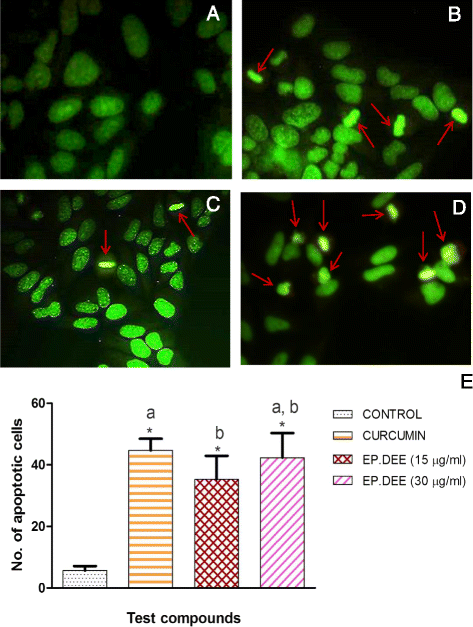Pro-apoptotic and cytotoxic effects of enriched fraction of Elytranthe parasitica (L.) Danser against HepG2 Hepatocellular carcinoma
- PMID: 27782823
- PMCID: PMC5080845
- DOI: 10.1186/s12906-016-1395-3
Pro-apoptotic and cytotoxic effects of enriched fraction of Elytranthe parasitica (L.) Danser against HepG2 Hepatocellular carcinoma
Abstract
Background: Hepatocellular carcinoma (HCC), the most common type of liver cancer accounts for more than one million deaths worldwide. Current treatment modality for HCC is marginally effective. Plants belonging to Mistletoe family (Loranthaceae) have been used in chemotherapy for many years. The present study was aimed at exploring the anti-proliferative, pro-oxidant and pro-apoptotic potential of stem of Elytranthe parasitica (L.) Danser (EP), a parasitic shrub belonging to Loranthaceae.
Methods: Elytranthe parasitica (L.) Danser, a climbing parasitic shrub was investigated for its cytotoxic activity against HepG2, a hepatocellular carcinoma cell line by Sulforhodamine B (SRB) assay. Further, pro-oxidant activity of EP extract/fractions was studied using copper phenanthroline assay. To understand the mechanism of cell death, the pro-apoptotic effects of Hep-G2 cells treated with EP extract/fractions were visualized by dual staining using acridine orange and ethidium bromide, a morphological marker of apoptosis. Phytochemical profiling of EP was explored by estimating the phenol, flavonoid and tannin content in its various fractions and extract. The occurrence of gallic acid, a principal polyphenol in EP extract and fractions was detected and further quantified using HPTLC (High Performance Thin Layer Chromatography) fingerprinting.
Result: Active fraction of Elytranthe parasitica, EP.DEE exhibited potent cytotoxic activity in a dose dependent manner against HepG2 hepatocellular carcinoma cell line with an IC50 of 56.7 ± 7.8 μg/mL. Dual staining with acridine orange and ethidium bromide revealed that HepG2 cells treated with EP active fractions underwent cell death chiefly by apoptosis. Highest phenol, flavonoid and tannin content were observed in active fractions, EP.EA (Ethyl acetate fraction) and EP.DEE (Diethyl ether fraction). Gallic acid was identified and quantified in EP extract and active fractions, EP.DEE and EP.EA.
Conclusion: Our findings indicate EP active fraction could be a promising contender in the treatment of hepatocellular carcinoma.
Keywords: Anti-proliferative; Apoptosis; Elytranthe parasitica; Gallic acid; HepG2; Hepatocellular carcinoma; Phytochemical.
Figures





References
MeSH terms
Substances
LinkOut - more resources
Full Text Sources
Other Literature Sources

